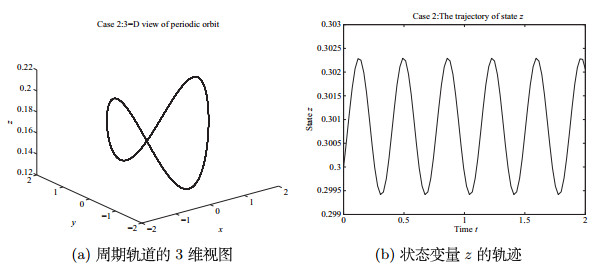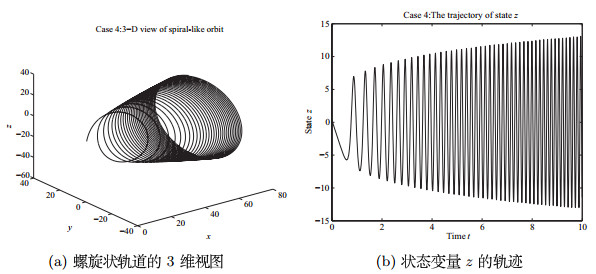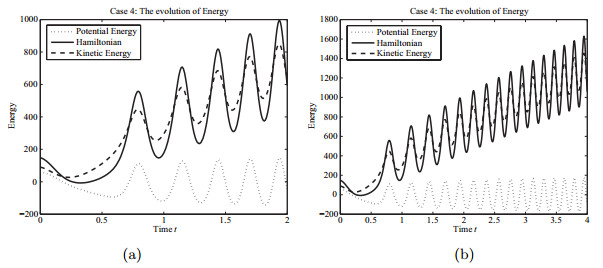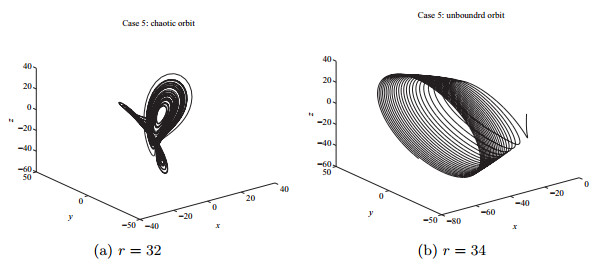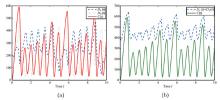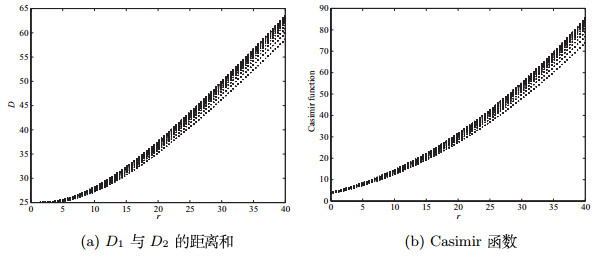Acta mathematica scientia,Series A ›› 2020, Vol. 40 ›› Issue (1): 243-256.
Dynamical Mechanism and Energy Conversion of Couette-Taylor Flow
- 1 College of Mathematics and Systematics Sciences, Shenyang Normal University, Shenyang 110034
2 College of Sciences, Liaoning University of Technology, Liaoning Jin'zhou 121001
-
Received:2018-03-22Online:2020-02-26Published:2020-04-08 -
Supported by:国家自然科学基金(11572146);沈阳师范大学博士启动基金(054-91900302009)
CLC Number:
- O175.1
Cite this article
Heyuan Wang. Dynamical Mechanism and Energy Conversion of Couette-Taylor Flow[J].Acta mathematica scientia,Series A, 2020, 40(1): 243-256.
share this article
Add to citation manager EndNote|Reference Manager|ProCite|BibTeX|RefWorks
"
| r值范围 | 0<acr<σ0 r1=1.4685 | acr>σ re=1.7532 rg=27.5452 rh=31.6102 | |||
| 定点O | 稳定结点 | 鞍结点(一个方向不稳,另两个方向稳定) | |||
| 定点P+和P- | 不存在 | 稳定结点 | 稳定结点 | 稳定结点 | 鞍点 |
| 系统(2.4)相空间中的运动情况 | 趋于稳定定态O | 趋于稳定定态P+或P- | 运动最终按螺旋线趋于P+或P- | 同左,但越靠近rh,轨线在P+和P-之间来回跳动的越频繁,出现暂态混沌,最终趋于P+或P- | 不稳定极限环(亚临界霍普夫分岔) |
| 动能 | 最小值 | 逐渐增大 | 保持增大 | 增长 | |
| Casimir函数 | 最小值 | 逐渐增大 | 保持增大 | 增长 | |
| D1与D2之和 | 不存在 | 逐渐递增 | 递增 | 逐渐增大 | |
| Coutte-Talor流的实际流动 | Couette流 | 形成规则的Talor涡流及Talor行进波等如图 1(a)(b)(c) | 经过波状涡流等达到暂态混沌如图 1(d) | 不规则湍流(混沌)如图 1(d) | |
| 1 | Chen F , Hsien D Y . A model study of stability of couette flow. Comm on Appl Math and Comput, 1987, 1 (2): 22- 33 |
| 2 |
Wang H Y . Lorenz systems for the incompressible flow between two concentric rotating cylinders. Journal of Partial Differential Equations, 2010, 23 (3): 209- 221
doi: 10.4208/jpde.v23.n3.1 |
| 3 | Wang H Y . The chaos behavior and simulation of three model systems of Couette-Taylor flow. Acta Mathematica Scientia, 2015, 35 (2): 769- 779 |
| 4 |
Feugainga Gassa , Crumeyrollea O , Yang K S , Mutabazia I . Destabilization of the Couette-Taylor flow by modulation of the inner cylinder rotation. European Journal of Mechanics-B/Fluids, 2014, 44, 82- 87
doi: 10.1016/j.euromechflu.2013.10.006 |
| 5 |
Ostilla R , Stevens R , Grossmann S , et al. Optimal Taylor-Couette flow:Direct numerical simulations. Journal of Fluid Mechanics, 2013, 719, 14- 46
doi: 10.1017/jfm.2012.596 |
| 6 | Wang H Y . Dynamical behaviors and numerical simulation of Lorenz systems for the incompressible flow between two concentric rotating cylinders. International Journal of Bifurcation and Chaos, 2012, 22 (5): 56- 73 |
| 7 | Chossat P , Looss G . The Couette-Taylor Problem. New York: Springer-Verlag, 1994 |
| 8 | Swinney H L , Gollub J P . Hydrodynamic Instablilities and the Transition to Turbulence. New York: Springer-Verlag, 1981 |
| 9 | Taylor G I . Stability of a viscous liquid contained between two rotating cylinders. Phil Trans Roy Soc A, 1923, 223, 289- 343 |
| 10 |
Thomas D G , Khomami B , Sureshkumar R . Nonlinear dynamics of viscoelastic Taylor-Couette flow, effect of elasticity on pattern selection, molecular conformation and drag. J Fluid Mech, 2009, 620, 353- 382
doi: 10.1017/S0022112008004710 |
| 11 | Anderreck C D , Liu S S , Swinney H L . Flow regimes in a circular Couette system with independent rotating cylinders. J Fluid Mech, 1986, 64, 155- 183 |
| 12 | 王贺元, 崔进. 旋转流动的低模分析及仿真研究. 应用数学与力学, 2017, 38 (7): 794- 806 |
| Wang H Y , Cui Jin . Low-dimensional analysis and numerical simulation of rotating flow. Applied Mathematics and Mechanics, 2017, 38 (7): 794- 806 | |
| 13 | Arnold V . Kolmogorov'S hydrodynamic attractors. Proc R Soc Lond A, 1991, 434 (19): 19- 22 |
| 14 |
Pasini A , Pelino V . A unified view of kolmogorov and lorenz systems. Phys Lett A, 2000, 275, 435- 446
doi: 10.1016/S0375-9601(00)00620-4 |
| 15 | Liang X Y , Qi G Y . Mechanical analysis and energy conversion of Chen chaotic system. General and Applied Physics, 2017, 47 (4): 288- 294 |
| 16 |
Liang X Y , Qi G Y . Mechanical analysis of Chen chaotic system. Chaos, Solitons and Fractals, 2017, 98, 173- 177
doi: 10.1016/j.chaos.2017.03.021 |
| 17 | Qi G , Liang X . Mechanical analysis of qi four-wing chaotic system. Nonlinear Dyn, 2016, 86 (2): 1095- 1106 |
| 18 |
Pelino V , Maimone F , Pasini A . Energy cycle for the lorenz attractor. Chaos Soliton Fract, 2014, 64, 67- 77
doi: 10.1016/j.chaos.2013.09.005 |
| 19 | Marsden J , Ratiu T . Introduction to Mechanics and Symmetry:A Basic Exposition of Classical Mechanical Systems (2nd edn). Berlin: Springer, 2002 |
| 20 | Strogatz S H . Nonlinear Dynamics and Chaos. MA: Perseus Books, Reading, 1994 |
| 21 | Morrison P J . Thoughts on brackets and dissipation:Old and new. Journal of Physics:Conference Series, 2009, 169 (1): 012006 |
| 22 | Doering C R , Gibbon J D . On the shape and dimension of the Lorenz attractor. Dyn Stab Syst, 1995, 10 (3): 255 |
| [1] | Zhi Wang,Litan Yan,Xianye Yu. Local Times of the Solution to Stochastic Heat Equation with Fractional Noise [J]. Acta mathematica scientia,Series A, 2019, 39(3): 582-595. |
| [2] | Wang Jianjun. On the Invariance of Maximal Distributional Chaos of Weighted Shift Operators on ∑(X) [J]. Acta mathematica scientia,Series A, 2018, 38(3): 446-453. |
| [3] | Yao Yuwu, Chen Xiu, Niu Xin. Distributional Chaos on Complex Sectors [J]. Acta mathematica scientia,Series A, 2017, 37(5): 950-961. |
| [4] | Wu Xinxing. A Remark on the Weak Specification Property [J]. Acta mathematica scientia,Series A, 2017, 37(4): 601-606. |
| [5] | Yang Jihua, Zhang Erli, Liu Mei. Dynamic Analysis and Chaos Control of a Finance System with Delayed Feedbacks [J]. Acta mathematica scientia,Series A, 2017, 37(4): 767-782. |
| [6] | Wang Heyuan, Cui Jin. The Analysis of Global Stability and Numerical Simulation of Chaos Behaviors of Rotating Flow [J]. Acta mathematica scientia,Series A, 2017, 37(4): 783-792. |
| [7] | Wang Heyuan. The Dynamical Behaviors and the Numerical Simulation of a Five-Mode Lorenz-Like System of the MHD Equations for a Two-Dimensional Incompressible Fluid on a Torus [J]. Acta mathematica scientia,Series A, 2017, 37(1): 199-216. |
| [8] | Wu Xinxing, Wang Jianjun. Some Remarks on P-Minimal Dynamical Systems [J]. Acta mathematica scientia,Series A, 2016, 36(5): 879-885. |
| [9] | Wang Heyuan. The Chaos Behavior and Simulation of Three Model Systems of Couette-Taylor Flow [J]. Acta mathematica scientia,Series A, 2015, 35(4): 769-779. |
| [10] | Lu Tianxiu, Zhu Peiyong, Wu Xinxing. Distributional Chaos in Nonautonomous Discrete Systems [J]. Acta mathematica scientia,Series A, 2015, 35(3): 558-566. |
| [11] | HU Han-Ping, LIU Shuang-Hong, WANG Zu-Xi, Wu Xiao-Gang. A Chaotic Poly phase Pseudorandom Sequence [J]. Acta mathematica scientia,Series A, 2004, 24(2): 251-256. |
| [12] | Zhang Jianfeng, Xie Xiangdong. Weak Transverse and Weak Chaos [J]. Acta mathematica scientia,Series A, 1998, 18(3): 241-245. |
| [13] | He Lianfa, Zhang Zhenguo. Chaos in the Semi-Flows and its Inverse Limit systems [J]. Acta mathematica scientia,Series A, 1997, 17(S1): 46-51. |
|






